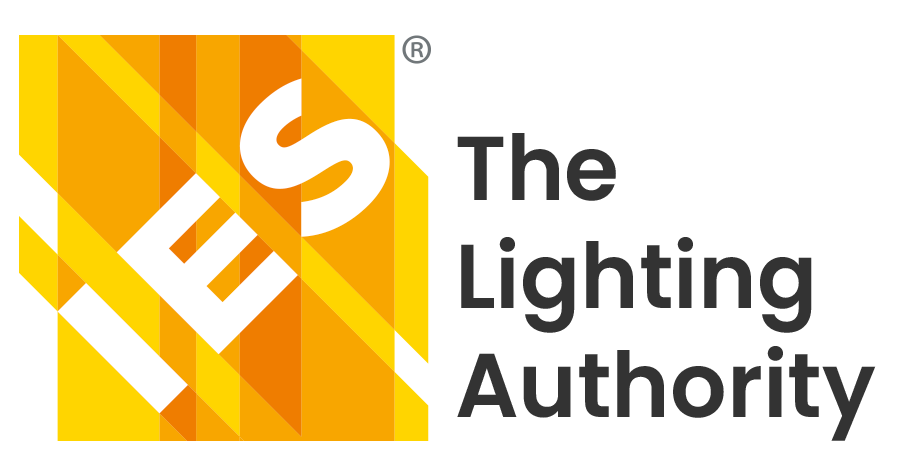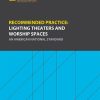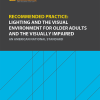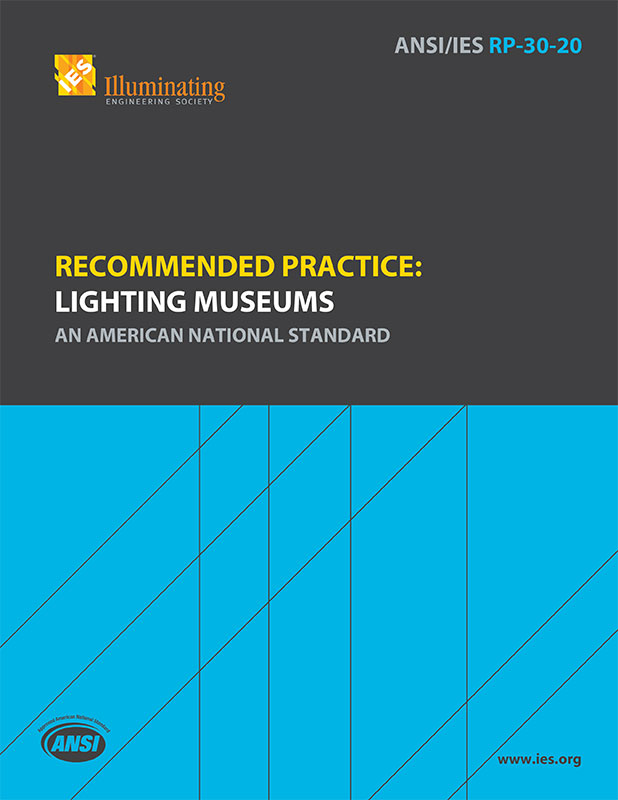Recommended Practice: Lighting Museums
$120.00
Member Price: $90.00
ANSI/IES RP-30-20
Document Type: Recommended Practice (RP)
Available as a downloadable secure PDF only.
To stay current with all IES standards, we recommend subscribing to the The Lighting Library as an Individual or through your company as a Sustaining Member.
In stock
Product Description
 Museums and art galleries collect, preserve, and display natural artifacts and/or examples of human achievement. Effective exhibit lighting should balance exhibition presentation goals (which enrich the visitor experience) with conservation techniques (intended to protect artifacts for appreciation by many generations to come.) While this document is intended primarily for lighting designers, other decision makers—such as the museum administrator, curator, conservator, and exhibit designer—can use it to improve understanding and communication throughout the exhibition process. The more the exhibition team understands both the aesthetic lighting design rules of thumb and general conservation techniques, the better will be the final presentation. The purpose of this document is to enhance the decision-making process by providing specific standards for satisfying the special requirements of museums and art galleries. Updated information is included on current lighting techniques and lighting technology. Exhibition lighting is the focus of this document, though information relating to other museum and art gallery applications is also addressed.
Museums and art galleries collect, preserve, and display natural artifacts and/or examples of human achievement. Effective exhibit lighting should balance exhibition presentation goals (which enrich the visitor experience) with conservation techniques (intended to protect artifacts for appreciation by many generations to come.) While this document is intended primarily for lighting designers, other decision makers—such as the museum administrator, curator, conservator, and exhibit designer—can use it to improve understanding and communication throughout the exhibition process. The more the exhibition team understands both the aesthetic lighting design rules of thumb and general conservation techniques, the better will be the final presentation. The purpose of this document is to enhance the decision-making process by providing specific standards for satisfying the special requirements of museums and art galleries. Updated information is included on current lighting techniques and lighting technology. Exhibition lighting is the focus of this document, though information relating to other museum and art gallery applications is also addressed.
Purchase includes RP-10-20+E1: Lighting Common Applications.
Page count: 104 pages
Publisher: Illuminating Engineering Society (2020)
SKU: ANSI/IES RP-30-20
ISBN-13: 978-0-87995-180-1
Chapters:
- Preface: Museums – By Howard Brandston
1.0 Introduction and Scope
2.0 The Museum Lighting Design Process
3.0 General Lighting Information
4.0 Luminaires, Light Sources, and Accessories
5.0 Lighting Control Systems
6.0 Economics, Maintenance, Sustainability
7.0 Museum Categories and Criteria for Lighting Design Success
8.0 Preservation of Light-Sensitive Materials
9.0 Typical Lighting Solutions for Museum Exhibitions
10.0 Daylighting the Museum Environment
Citation Format:
Illuminating Engineering Society. ANSI/IES RP-30-20, Recommended Practice: Lighting Museums. New York: IES; 2020.
CONTENTS
- Preface: Museums – By Howard Brandston
- 1.0 Introduction and Scope
- 1.1 Introduction
1.1.1 Integrated Design - 1.2 Scope
- 2.0 The Museum Lighting Design Process
- 2.1 Lighting Concept: Pre-design Phase
- 2.2 Schematic Design: Assessment Phase
- 2.3 Design Development: Defining Solutions Phase
- 2.4 Construction Documentation: Final Design Phase
- 2.5 Contract Administration: Commissioning and Installation Phase
- 2.6 Project Completion: Reflection on Design and Lessons Learned
- 3.0 General Lighting Information
- 3.1 Illuminance (and Related Properties)
3.1.1 Illuminance Criteria
3.1.2 Luminance
3.1.3 Irradiance - 3.2 Light Distribution
3.2.1 Luminaire Photometry
3.2.2 Controlling the Distribution of Light
3.2.3 IES Method for Creating Focus - 3.3 Color
3.3.1 Color Assessment Factor 1: The Effect of Illuminance on Color Appearance
3.3.2 Color Assessment Factor 2: Chromaticity
3.3.3 Color Assessment Factor 3: Color Rendering
3.3.4 Visual Assessment of Color Quality: The Mockup
3.3.5 Conclusion - 3.4 Movement
- 3.5 Angle
3.5.1 Modeling of Three-Dimensional Forms
3.5.2 Location of Luminaires
3.5.3 Lighting the Background
3.5.4 You Cannot Light a Mirror
3.5.5 Sparkle and Nuisance Glare
3.5.6 Direct Glare
3.5.7 Veiling Reflections (Reflected Glare)
3.5.8 Spatial Brightness Appearance
3.5.9 Glare Summary - 3.6 Controllable Qualities of Light: Summary
- 4.0 Luminaires, Light Sources, and Accessories
- 4.1 Basic Types of Luminaires Used for Direct Lighting
4.1.1 Lamp-Based Performance Luminaires
4.1.2 Integrated-Source Performance Luminaires - 4.2 Incumbent Source vs. Replacement or Retrofit Source
- 4.3 Luminaire Construction and Safety
- 4.4 Efficacy, Efficiency, and Life
- 4.5 Flicker
- 4.6 Museum Lighting Applications and Techniques: Relationship to Luminaires
4.6.1 Special Effects Lighting
4.6.2 Safety and Security with Track Lighting
4.6.3 Picture Lights - 4.7 Luminaire Accessories
4.7.1 Glass Spread Lenses and Beam Softeners
4.7.2 Dichroic Glass and Narrow B Filters
4.7.3 UV and IR Filtering
4.7.4 Filters, Color Filters, and Thin-Film Diffusers
4.7.5 Glare Control
4.7.6 Beam Manipulation and Pattern Projection - 4.8 Track Lighting
- 4.9 Fiberoptic Systems
- 5.0 Lighting Control Systems
- 5.1 Types of Lighting Controls
5.1.1 Switches, Wall Box Dimmers, and Contactors
5.1.2 Circuit-Level Automated Controls
5.1.3 Integration of Lighting Controls with Other Systems - 5.2 Control System Fundamentals and Hardware Elements
5.2.1 Sensors
5.2.2 User Interfaces with the Lighting Control System
5.2.3 Control Locations - 5.3 Matching Power Control Equipment with Light Sources
- 6.0 Economics, Maintenance, Sustainability
- 6.1 Maintenance
- 6.2 Lighting Budgets and Economics
- 6.3 Sustainable Lighting Design for Museums and Art Galleries
- 7.0 Museum Categories and Criteria for Lighting Design Success
- 7.1 Types of Museums and Art Galleries
- 7.2 Criteria for Successful Museum Lighting
- 8.0 Preservation of Light-Sensitive Materials
- 8.1 Damage Factor 1: A Material’s Susceptibility to Light
8.1.1 General Susceptibility to Damage Based on the SPD of the Light Source
8.1.2 Relative Rate of Damage Based on the Extent of Previous Exposure
8.1.3 Relative Rate of Damage over Time, Based on the Light Sensitivity of an Object - 8.2 Damage Factor 2: The Concentration of Irradiance on the Surface of a Material
8.2.1 Illuminance - 8.3 Damage Factor 3: Duration of Exposure and the Principle of Reciprocity
- 8.4 Damage Factor 4: The Spectral Power Distribution of Light Sources (UV, IR, and Visible)
8.4.1 Ultraviolet (UV) Radiation
8.4.2 Infrared (IR) Radiation and Thermal Management
8.4.3 Spectrum of Visible Radiation
8.4.4 Specific Susceptibility to Damage Based on Light Source Spectrum - 8.5 Preservation of Light-Sensitive Materials: Summary
- 9.0 Typical Lighting Solutions for Museum Exhibitions
- 9.1 Flat Objects on Vertical Surfaces
9.1.1 Wall Wash
9.1.2 Spotlights - 9.2 Large-Scale Three-Dimensional Objects
9.2.1 Minimizing Glare - 9.3 Exhibit Cases
9.3.1 Built-In Cases
9.3.2 Freestanding Cases: General Considerations
9.3.3 Freestanding Glass Cases: Four-Sided Plus Solid Top
9.3.4 Freestanding Glass Cases: Four-Sided Plus Glass Top (Five-Sided)
9.3.5 Grand Cases
9.3.6 Mini-cases
9.3.7 Table Cases with Flat Tops
9.3.8 Table Cases: Lectern Type
9.3.9 Wall Cases
9.3.10 Common Elements of Display Cases
9.3.11 Case Checklist
9.3.12 Case Reflections - 9.4 Dioramas
9.4.1 Concealed Lighting Locations
9.4.2 Dual Lighting - 9.5 Typical Lighting Solutions: Summary
- 10.0 Daylighting the Museum Environment
- 10.1 Daylight in Architectural Lighting Design
10.1.1 Sunlight
10.1.2 Sky Light
10.1.3 Reflected Light from Sun or Sky - 10.2 Energy and Damage
10.2.1 Light and Ultraviolet (UV) Energy
10.2.2 Nonvisible Spectrum (IR) - 10.3 Daylighting Design in Museums
10.3.1 Daylight as Object Illuminant
10.3.2 Daylight as Architectural Illuminant
10.3.3 View Provision
10.3.4 Visual Comfort
10.3.5 Energy Savings - 10.4 Daylighting Techniques and Typologies
10.4.1 Sidelighting
10.4.2 Toplighting
10.4.3 Combinative Strategies
10.4.4 Shading Devices - 10.5 Performance Metrics
10.5.1 Object Illuminance and Luminance
10.5.2 Values Used to Assess Damage or Risk: Maximum Instantaneous Value
10.5.3 Values Used to Assess Damage or Risk: Cumulative Value
10.5.4 Values Used to Assess Damage or Risk: SDF Curves
10.5.5 Recommended Ratios and Maximum Value
10.5.6 Glare
10.5.7 Damage Concerns - 10.6 Color Metrics
10.6.1 SPD, Chromaticity, and Correlated Color Temperature (CCT)
10.6.2 Color Rendering - 10.7 Documentation and Testing
10.7.1 Daylighting Specifications
10.7.2 Programming and Verification
10.7.3 Commissioning
10.7.4 Operational Issues - Annex A – Illuminance Recommendations
- Annex B – Key Color Terms, Concepts, and Phenomena
- Annex C – Sensitivity of Colored Materials to Light and UV Energy
- Annex D – Flow Chart For Managing Light-Sensitive Materials
- Annex E – Light Measurement Tools and Techniques
- Annex F – Lighting for Special Events in Museums and Art Galleries
- Annex G – Fundamental Factors of Artifact Visibility
- Annex H – Electric Light Source Considerations
- Annex I – Museum Terms
- References



